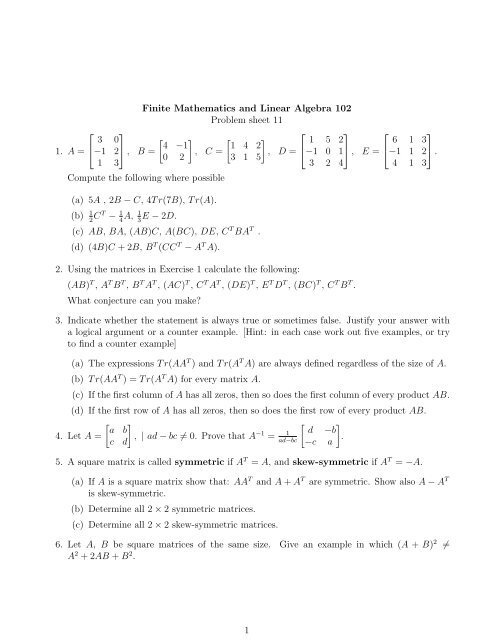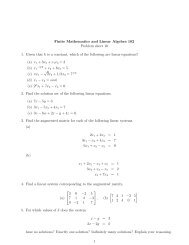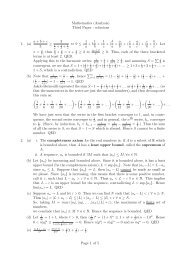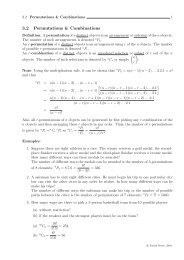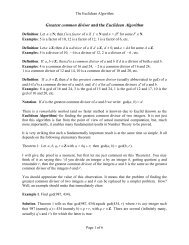Finite Mathematics and Linear Algebra 102 Problem sheet 11 ... - DCU
Finite Mathematics and Linear Algebra 102 Problem sheet 11 ... - DCU
Finite Mathematics and Linear Algebra 102 Problem sheet 11 ... - DCU
You also want an ePaper? Increase the reach of your titles
YUMPU automatically turns print PDFs into web optimized ePapers that Google loves.
<strong>Finite</strong> <strong>Mathematics</strong> <strong>and</strong> <strong>Linear</strong> <strong>Algebra</strong> <strong>102</strong><br />
<strong>Problem</strong> <strong>sheet</strong> <strong>11</strong><br />
⎡ ⎤<br />
⎡ ⎤ ⎡ ⎤<br />
3 0 [ ] [ ] 1 5 2<br />
6 1 3<br />
1. A = ⎣−1 2⎦ 4 −1 1 4 2<br />
, B = , C = , D = ⎣−1 0 1⎦ , E = ⎣−1 1 2⎦ .<br />
0 2 3 1 5<br />
1 3<br />
3 2 4<br />
4 1 3<br />
Compute the following where possible<br />
(a) 5A , 2B − C, 4T r(7B), T r(A).<br />
(b) 1 2 CT − 1 4 A, 1 3 E − 2D.<br />
(c) AB, BA, (AB)C, A(BC), DE, C T BA T .<br />
(d) (4B)C + 2B, B T (CC T − A T A).<br />
2. Using the matrices in Exercise 1 calculate the following:<br />
(AB) T , A T B T , B T A T , (AC) T , C T A T , (DE) T , E T D T , (BC) T , C T B T .<br />
What conjecture can you make?<br />
3. Indicate whether the statement is always true or sometimes false. Justify your answer with<br />
a logical argument or a counter example. [Hint: in each case work out five examples, or try<br />
to find a counter example]<br />
(a) The expressions T r(AA T ) <strong>and</strong> T r(A T A) are always defined regardless of the size of A.<br />
(b) T r(AA T ) = T r(A T A) for every matrix A.<br />
(c) If the first column of A has all zeros, then so does the first column of every product AB.<br />
(d) If the first row of A has all zeros, then so does the first row of every product AB.<br />
[ ]<br />
[ ]<br />
a b<br />
d −b<br />
4. Let A = , | ad − bc ≠ 0. Prove that A<br />
c d<br />
−1 = 1<br />
.<br />
ad−bc −c a<br />
5. A square matrix is called symmetric if A T = A, <strong>and</strong> skew-symmetric if A T = −A.<br />
(a) If A is a square matrix show that: AA T <strong>and</strong> A + A T are symmetric. Show also A − A T<br />
is skew-symmetric.<br />
(b) Determine all 2 × 2 symmetric matrices.<br />
(c) Determine all 2 × 2 skew-symmetric matrices.<br />
≠<br />
6. Let A, B be square matrices of the same size. Give an example in which (A + B) 2<br />
A 2 + 2AB + B 2 .<br />
1
7. A matrix A is said to be an involution is A 2 = I. Note A 2 = A · A.<br />
[ ] 1 −2<br />
(a) Show that is an involution.<br />
0 −1<br />
[ ] 5 3<br />
(b) Find the values of a <strong>and</strong> b for which the matrix is an involution.<br />
a b<br />
(c) Find six different 2 × 2 matrices which are involutions <strong>and</strong> are skew-symmetric.<br />
(d) Suppose A is an n × n matrix which is also an involution. What is A −1 .<br />
8. Let A be an n × n matrix. Let A n be the product A · A · A.. · A, the product A with itself n<br />
times. Show that (A n ) −1 = (A −1 ) n .<br />
2


